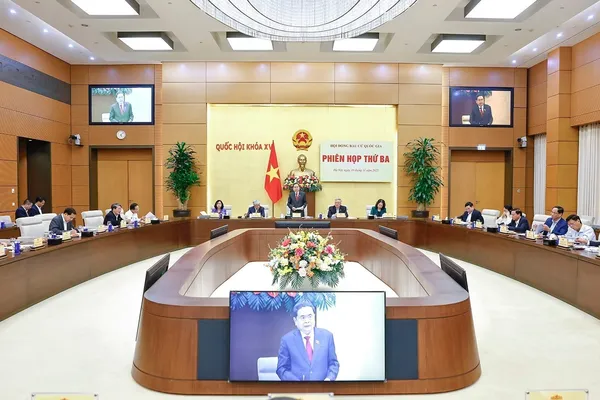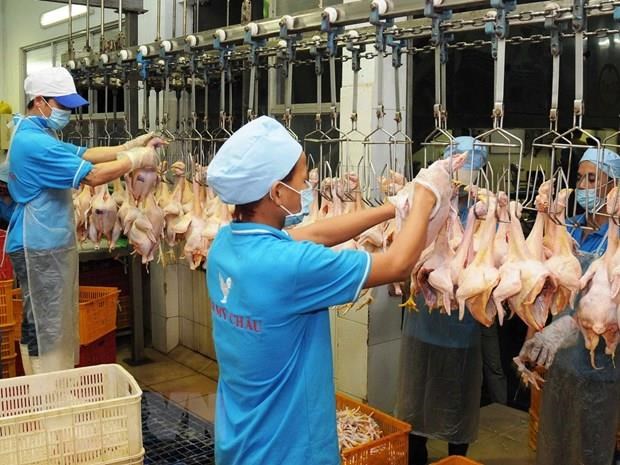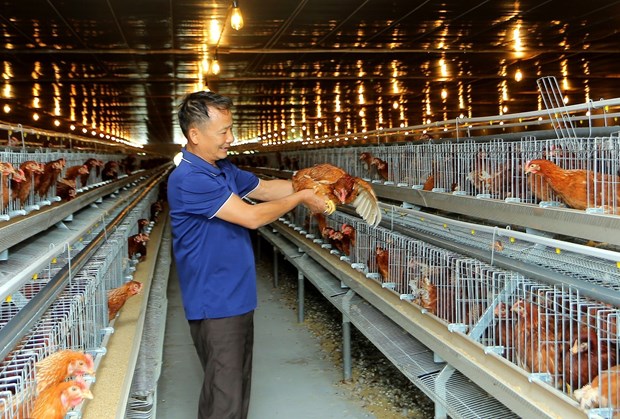 Economy
Economy


|
| A modern chicken slaughter line at the CP Livestock Joint Stock Company. — VNA/VNS Photo An Hiếu |
HÀ NỘI — Poultry farmers and businesses face many difficulties when output increases, but the selling price is often lower than the cost price.
Things are even more difficult when domestic supply is higher than demand, but the import of poultry meat into Việt Nam continues to increase.
Việt Nam is one of the countries with the largest total poultry population in the world.
In 2018-2022, poultry increased rapidly from 435.9 million to 557.3 million. The average growth rate was 6.3 per cent a year.
In the first quarter of 2023, the number of poultry was 551.4 million, up 2.4 per cent; poultry meat was over 563,000 tonnes, up 4.2 per cent; 4.7 billion eggs, up 4.5 per cent over the same period in 2022.
The continuous increase in poultry meat production has caused supply to exceed demand and low selling prices, causing losses to poultry farmers.
At a meeting to assess the situation and propose solutions to livestock production held in Hà Nội on Thursday, the chairman of the Poultry Breeding Association, Nguyễn Thanh Sơn, said profit margins are falling sharply, and the situation is alarming.
The selling price of chicken meat is continuously below the cost price of VNĐ6,000-8,000 (US$0.26-0.34) per kilogram, causing losses for both FDI enterprises and small-scale farming households.
He also pointed out that the growth in the import of chicken meat is higher than that of domestic production (imports increase by nearly 60 per cent a year, but production increases by just over 6 per cent).
This puts more pressure on domestic poultry production while supply is exceeding demand.
The fluctuating consumption causes losses for both businesses and farmers in maintaining raising poultry, capital shortage and risk of production suspension, Sơn said.
"In 2022, Việt Nam imported nearly 3.4 million poultry for breeding, leading to a strong increase in the number of poultry," said Tống Xuân Chinh, deputy director of the Department of Livestock Production, Ministry of Agriculture and Rural Development. "Production capacity is large, and domestic consumption is limited, causing a greater supply than demand."
Talking about the difficulties in the poultry industry, Chinh said high input price, especially the price of animal feed, has caused many difficulties for businesses and farmers.
The decline of the world economy in general and Việt Nam's economy, in particular, is affecting the livestock industry, according to Deputy Minister of Agriculture and Rural Development Phùng Đức Tiến.
The economic recession has led to the suspension of operations and the reduction of workforce of many large enterprises, affecting the purchasing power of the market for livestock products, including poultry meat and eggs, he said.
Fluctuating prices of livestock products have discouraged farmers.

|
| A chicken raising model in Từ Sơn City, Bắc Ninh Province. — VNA/VNS Photo |
The industry's difficulty is also due to the instability of the market, poor forecasting, and high costs of input materials.
Meanwhile, farmers have lacked capital and land to invest and develop livestock farms, the deputy minister said.
“Food prices had fallen sharply," Tiến said. "In the past three years, the selling price was often lower than the production cost. The livestock industry needs to raise radical solutions in the context that livestock production is still growing."
Solutions
Sơn said that it is necessary to review the strategy on livestock development.
"We have been busy increasing production for a long time, causing supply to exceed demand and low price," Sơn said. "We should enhance, add value and scrutinise new projects before licensing."
Export market expansion should be promoted. However, the World Organization for Animal Health regulations on disease-free zones are causing difficulties for poultry exporters.
Many enterprises have failed to meet the requirements of importers, he added.
Strict control of the import of livestock products is also needed.
It is necessary to have strong enough technical measures to limit the import of frozen chicken meat, control the smuggling of chickens across the border and closely monitor livestock products temporarily imported for re-export.
At the conference, representatives of businesses and poultry farmers also asked the Ministry of Agriculture and Rural Development to propose preferential credit policies, corporate income tax reduction, the import tax on animal feed ingredients and specific policies to support domestic enterprises and breeders to compete fairly with FDI enterprises.
To create a breakthrough in the growth of the export of livestock products, Sơn suggested the Ministry of Agriculture and Rural Development coordinate with the Ministry of Industry and Trade to develop and implement medium and long-term programmes to export several main livestock products.
Along with boosting exports, relevant ministries must coordinate with industry associations to build technical barriers for the import market, aiming to create a healthy competitive environment for domestically-produced products.
Sơn also proposed ministries and sectors to review and reduce administrative procedures and logistics costs in the animal feed production chain, contributing to reducing production costs.
The Ministry of Agriculture and Rural Development will review the poultry scale and assess the quality and productivity of poultry to set development directions for each locality, said the Deputy Minister of Agriculture.
Industrial farming models, applying high technology and organic production will also be promoted. — VNS




